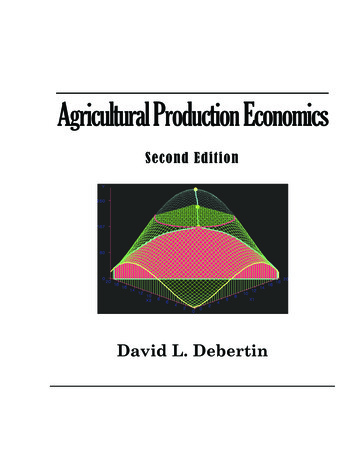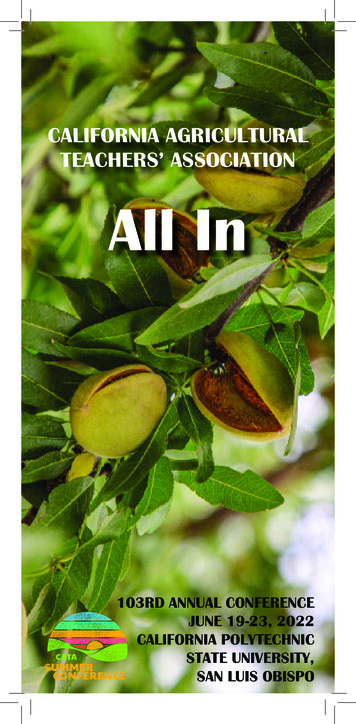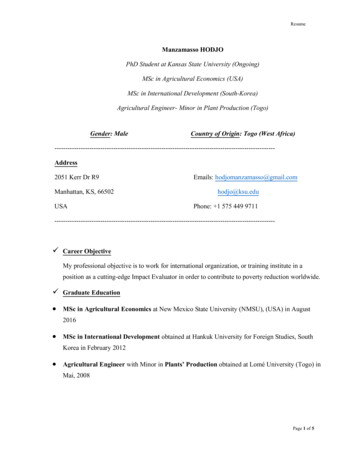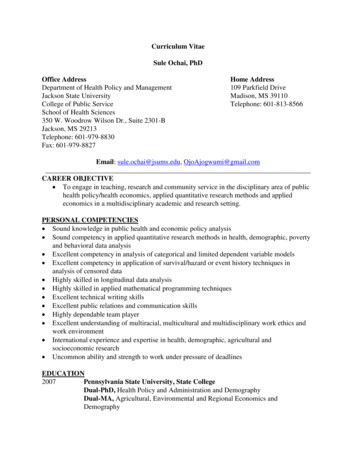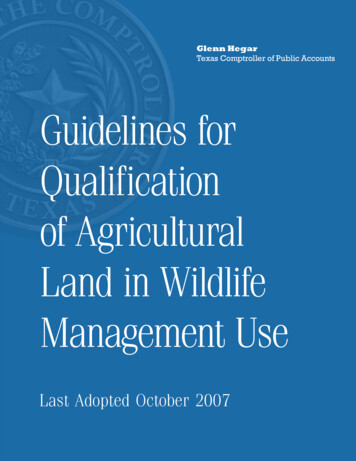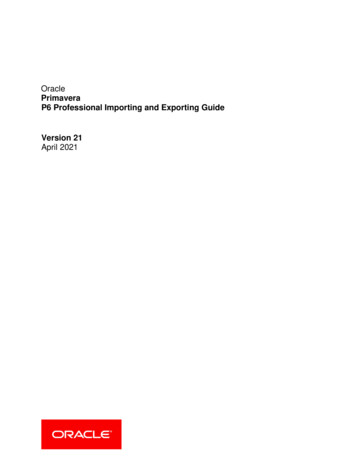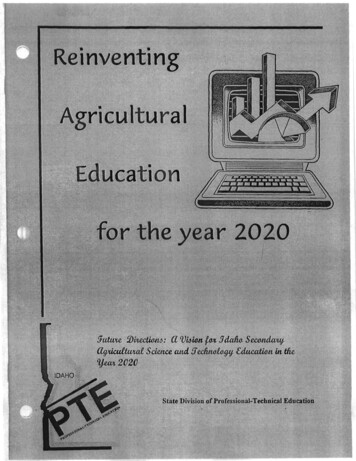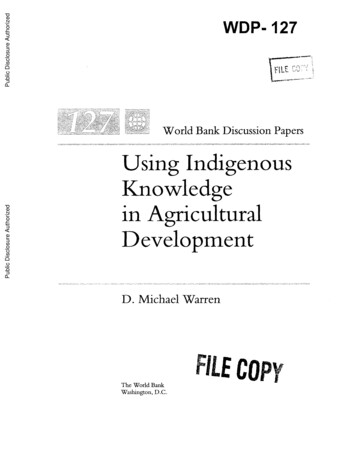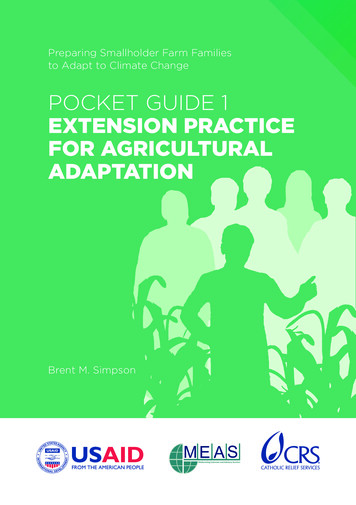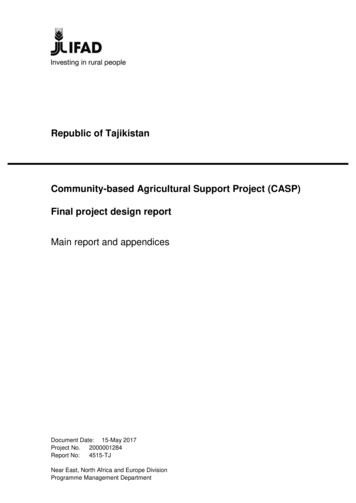
Transcription
Republic of TajikistanCommunity-based Agricultural Support Project (CASP)Final project design reportMain report and appendicesDocument Date: 15-May 2017Project No. 2000001284Report No:4515-TJNear East, North Africa and Europe DivisionProgramme Management Department
Republic of TajikistanCommunity-based Agricultural Support Project (CASP)Final project design reportContentsCurrency equivalentsiiiWeights and measuresiiiAbbreviations and acronymsivMap of the project areaviiExecutive SummaryviiiResults FrameworkxiiI.II.III.IV.Strategic context and rationale1A.Country and rural development context1B.Rationale8Project description10A.Project area and target group10B.Development objective and impact indicators10C.Outcomes/Components10D.Lessons learned and adherence to IFAD policies17Project implementation19A.Approach19B.Organizational framework20C.Planning, M&E, learning and knowledge management26D.Financial management, procurement and governance28E.Supervision30F.Risk identification and mitigation30Project costs, financing, benefits and sustainability31A.Project costs31B.Project financing32C.Summary benefits and economic analysis35D.Sustainability36List of FiguresFigure 1: Vulnerability map for Tajikistan (10 agro ecological zones)43List of TablesTable 1: Source of monetary income of an average rural household (per person per month)5Table 2: Project Costs by Components32Table 3: Financing Plan by Components – including contingencies (‘000 US )33Table 4: Expenditure Accounts by financier (‘000 US )34i
Republic of TajikistanCommunity-based Agricultural Support Project (CASP)Final project design reportAppendicesAppendix 1:Country and rural context background39Appendix 2:Poverty, targeting and gender47Appendix 3:Country performance and lessons learned59Appendix 4:Detailed project description63Appendix 5:Institutional aspects and implementation arrangements79Appendix 6:Planning, M&E and learning and knowledge management113Appendix 7:Financial management and disbursement arrangements117Appendix 8:Procurement127Appendix 9:Project cost and financing135Appendix 10:Economic and Financial Analysis141Appendix 11:Draft project implementation manual169Appendix 12:Compliance with IFAD policies171Appendix 13:Contents of the Project Life File173ii
Republic of TajikistanCommunity-based Agricultural Support Project (CASP)Final project design reportCurrency equivalentsCurrency Unit US 1.0 Weights and measures1 kilogram 1000 g1 000 kg 2.204 lb.1 kilometre (km) 0.62 mile1 metre 1.09 yards1 square metre 10.76 square feet1 acre 0.405 hectare1 hectare 2.47 acresiii
Republic of TajikistanCommunity-based Agricultural Support Project (CASP)Final project design reportAbbreviations and ICARDAIDAIFADIGAIMFINGOAsian Development BankAga Khan FoundationAgricultural Mechanization Service CentreAdaptation for Smallholder Agriculture ProgrammeAgriculture Training and Advisory CentreAnnual Work Plan and BudgetBusiness Development ServicesCentral Asian Countries’ Initiative on Land ManagementCatholic Agency for Overseas Aid and DevelopmentClimate ChangeCommunity Development FundsCommunity Development SpecialistCommunity FacilitatorCommunity Grant AgreementClimate Investment FundsCommon Interest GroupCommonwealth of Independent StatesCommunity Livestock and Pasture Management PlanConcept NoteCommunity OrganizationDonor Coordination CouncilDistrict Development CommitteesDepartment for International Development (United Kingdom)District Project OfficerEurasian Economic UnionEuropean Bank for Reconstruction and DevelopmentEurope and Central AsiaEuropean CommissionEconomist Intelligent UnitEconomic Internal Rate of ReturnFood and Agriculture Organization of the United NationsFemale Headed HouseholdFinancial Internal Rate of ReturnFinancial ManagementFormer Soviet UnionGross Agricultural OutputGender Action PlanGender Development IndexGross Domestic ProductGerman International CooperationGross National IncomeGovernment of TajikistanHuman Development IndexHouseholdInternational Center for Agricultural Research in the Dry AreasInternational Development AssociationInternational Fund for Agricultural DevelopmentIncome Generating ActivityInternational Monetary FundInternational Non-Governmental Organisationiv
Republic of TajikistanCommunity-based Agricultural Support Project (CASP)Final project design SToTTORUNDPUSAIDUS VOWBWFPWGInternal Rate of ReturnJamoat CouncilJoint Country Support StrategyKnowledge ManagementKhatlon Livelihoods Support ProjectLivestock and Pasture Development ProjectLivestock Unit (equal to one adult sheep)Monitoring and EvaluationMicrofinance InstitutionManagement Information SystemMinistry of AgricultureMinistry of FinanceMemorandum of UnderstandingMountain Societies Development Support ProgrammeMetric tonNational Academy of Agricultural SciencesNational Bank of TajikistanNational Development StrategyNon-Governmental OrganisationNet Present ValuePortfolio at riskProject Implementation ManualProject Management UnitPurchasing Power ParityPoverty Reduction Strategy (Paper)Project Steering CommitteePasture Users’ UnionPUU BoardProject YearResults and Impact Management SystemRayons of Republican SubordinationState Committee for Land Management and GeodesyStrategic Climate FundState Committee on Investments and State Property ManagementSwiss Development CooperationSpecial Drawing Right(s)Swedish International Development AgencySmall and Medium EnterprisesLocal currencyStrengths, Weaknesses, Opportunities and ThreatsTechnical AssistanceTajik Agrarian UniversityTajikistan Living Standards SurveyTraining of TrainersTerms of ReferenceUnited Nations Development ProgrammeUnited States Agency for International DevelopmentUnited States DollarVillage OrganizationWorld BankWorld Food ProgrammeWomen Groupv
Republic of TajikistanCommunity-based Agricultural Support Project (CASP)Final project design reportDefinitions and GlossarySmallholder farmersSmallholder farmers refer to those with small sizes of agricultural land thatrely mainly on family labour. In Tajikistan, smallholder farmers usuallyhave access to small plots (0.15-0.40 ha) for crops near the homestead(often called ‘kitchen gardens’), over which they have a permanent andheritable use right. Some of them might have received additional smallplots, commonly called ‘Presidential Lands’. In addition to those croplands, smallholder farmers would have access to communal pasture landfor grazing animals.Dehkan farmsDehkan farms are run by private persons at individual, family or collectivelevels. The size of dehkan farms varies from five to thousands ofhectares. Family and collective dehkan farms appoint a head whoofficially holds the farm’s land registration certificate and legallyrepresents the interests of the farm. Many large collective dehkan farms,however, continue to operate as collective or state farms.Village OrganizationsVillage Organizations (VOs) are the community-based organizations atthe village level. Initially started with support from the Mountain SocietiesDevelopment Support Programme (MSDSP) of the Aga Khan Foundation,creating a grassroots organizational entity to represent the villagecommunity, VOs gained momentum and their numbers have increasedsharply. The VO concept and functions have been mainstreamed, andVOs currently have a legal status under the Law on Public Self-InitiativeBodies and cover basically all the country. VOs are recognized bodies byboth the government and donors as focal points for linking and workingwith communities though are underfunded and in some cases have weekgovernance.MahallaMahalla means a traditional forum of self-governance at theneighbourhood community level. Traditionally, it was governed by acouncil of elders. Mahalla in its current usage is understood as a socialunit/community with mechanisms of self-governance.JamoatJamoats are the third-level administrative divisions (below district orrayon) in Tajikistan or sub-districts. There are about 406 Jamoats in thecountry.HukumatHukumat refers to a local government/state administration. Hukumatsoperate at region and district levels.vi
Republic of TajikistanCommunity-based Agricultural Support Project (CASP)Final project design reportMap of the project areavii
Republic of TajikistanCommunity-based Agricultural Support Project (CASP)Final project design reportExecutive SummaryCountry context and sectoral strategyTajikistan is a landlocked country bordering Afghanistan in the south, China in the east, Kyrgyzstan inthe north, and Uzbekistan in the west. The country’s population reached 8.5 million people in 2015.The country has one of the lowest per capita GDPs among the 15 former Soviet republics. The grossnational income (GNI) per capita (Atlas method, current US ) was estimated at US 1,280 in 2015.The country has a narrow economic base dominated by the production of aluminium and cotton, thetwo main export commodities, supplemented by remittances from Tajik nationals working abroad. 5.Agriculture is a major component of the Tajik economy. In 2015 it accounted for 25% of GDP and itplays a significant role in the rural population’s livelihood and food security. In 2015 agricultureemployed 45% of the workforce, according to government statistics. Despite its critical importance,the agricultural resource base is characterized by limited arable land. The agricultural sector is ingeneral characterized by poor efficiency and productivity and incomes are low. Key factors that limitdevelopment include lack of access to: finance, modern agricultural machinery and equipment,modern technologies and farming practices, and agro-services.Tajikistan was one of the poorest members of the former USSR and after independence povertyincreased sharply as a result of an abrupt termination of economic support from the Soviet Union andan extended civil war after independence in 1991, derailing all economic activity. However, progresshas been made as available data show that poverty declined from 81% in 1999 to about 32% in 2014.One fifth of the population in Tajikistan is affected by food insecurity. The incidence of poverty isabove average in rural areas (36.1%) which host over 80% of the total poor.The productivity of the agricultural sector is significantly constrained by the limited access toagricultural machinery and equipment, services for operation and maintenance for the existingequipment. The inventory of agricultural machinery was largely destroyed during the civil war in the1990’s together with the related service infrastructure. Investments in agricultural machinery resumedin 2000, but at a very narrow pace and scale due to limited access to finance. By and large, theagricultural mechanization condition in Tajikistan is considered responsible for lowering cropproductivity by 20% and in worst cases by 30%. Reasons behind this comprise improper and untimelyland preparation and seeding planning, inadequate land operations, and low performing harvestings.The overall framework for development in Tajikistan is guided by the Government’s NationalDevelopment Strategy 2016-2030 (NDS) and Medium-term Development Strategy 2016-2020 (MDS).The strategic development goals of the NDS are: (i) ensuring energy security; (ii) development of thecountry’s communication opportunities; (iii) ensuring food security and nutrition; and (iv) enhancingproductive employment. These will be achieved by the following tenets of a new model of growth: (i)improvement of public governance for sustainable development; (ii) development of a new institutionalsupport system for the private sector and improvement of the business environment and investmentclimate; and (iii) improving the productivity of human capital. The Ministry of Agriculture has drafted anambitious plan of reforms that are described in its main programmatic document (Reform Programmeof the Agriculture Sector - 2012-2020). Despite the fact that the MOA has limited budgetary resources,poorly trained staff and low salaries that have contributed to weak administration, public servicedelivery and knowledge management, it has the potential to ensure proper management of resources.Since 2008, the IFAD Country Programme has invested about US 49.3 million in three projects inTajikistan, thus mobilising overall investments of US 54.9 million. IFAD interventions are directlybenefitting some 80,000 households by strengthening their local institutions and grassrootsorganizations, and expanding their access to productive technologies and resources. IFAD’s currentcountry programme consists of the Livestock and Pasture Development Project I and II). The projectsfocus on income diversification and promote alternative sources of income so as to diversifyhousehold economies.viii
Republic of TajikistanCommunity-based Agricultural Support Project (CASP)Final project design reportJustification and rationaleAgricultural productivity is far below its potential including for key smallholder staples such as wheatand potato; and cash crops such as apple. This severely impacts the livelihoods of the project targetgroup. A pivotal cause is lack of access to modern technologies, notably farm equipment andmachinery and their service network. Also, poor rural production and transport infrastructure (ruralaccess roads and bridges, livestock watering points), degraded land/pastureland, and the risks ofclimate change limit the optimal use of the natural resource base. The theory of change (TOC) ispremised on tackling these problems using a two-pronged approach: on one hand in support of thepoorest smallholders in remote villages who cannot access mechanization services except on a highlyconcessional basis; on the other in support of private sector mechanized Service Providers and repair& maintenance services, on whose participation the long-term sustainable growth of the sectordepends.Project area and target groupsThe Project will be implemented in selected districts of Soghd, Khatlon and RRS, which have highpoverty levels, yet potential for agriculture development. It is expected that the Project will reacharound 225 villages with an estimated population of 48,160 households. The Project will seek toprovide benefits to the actually or potentially economically active among the following primary targetgroups: (i) rural poor living in extreme poverty, who are either landless or are producing a baresubsistence minimum on HH plots; (ii) subsistence and semi-subsistence farmers, in particular thosewilling to move to more commercial farming; (iii) the rural underemployed and self-employed; and (iv)private entrepreneurs with actual or potential strong backward linkages to poor rural communities inthe capacity of service provider, input supplier or off-taker of agricultural produce. Within thesegroups, emphasis will be placed on reaching poor rural women, especially those who are HH heads,and poor rural youth.Project goal, objectives, outcomes and approachThe Project goal is to stimulate inclusive economic growth and reduction of poverty in poor ruralcommunities. The development objective of the Project is to improve access of communities toproductive infrastructure and services leading to sustainable agricultural production and equitablereturns. Project implementation will be guided by the Project’s results management framework. TheProject’s investments and activities will be executed through two components in addition to ProjectManagement: Component 1. Strengthening rural institutions; and Component 2. Improvement ofagricultural productivity and business linkages.The aim of Component 1 is two-fold: (i) to scale-up strengthening of Village Organizations (VOs) andto develop business-oriented dehkan farmer groups; and (ii) to build capacities of implementationservice agencies (public/private) to deliver goods and services to smallholder farmers. The former willhelp expand benefits to a larger number of dehkan/individual smallholder farmers. The latter willcontribute to enhancing sustainability of implementation capacity from which the GOT and otherdevelopment actors can draw to expand the activities beyond the Project period to other areas. Thus,the outcome of this Component is: “increased effectiveness and outreach of rural institutions andservice agencies”. The outcome will be measured by the following indicator: 70% of beneficiariessatisfied with the services provided by rural institutions and service agencies.The aim of Component 2 is to build communities’ productive base and to stimulate adoption ofmodern agricultural technologies leading to improved agricultural productivity. Thus, the outcome ofthis Component is: “increased farm productivity resulted through adoption of improved agriculturaltechnologies and productive infrastructure”. The additional outcome of the Component is“acknowledged policy recommendations on tested mechanization improvement options”. The firstoutcome will be measured by the following indicators: (i) at least 20% increase in agriculturalproductivity (by main commodities); and (ii) at least 35,000 hectares under improved environmentallysustainable management practices. The additional outcome will be accomplished by a deliveredPolicy paper on improved mechanization.The approach of the Project is to improve the assets and incomes of selected rural communities,including smallholder farmers, small rural processing enterprises, input suppliers and serviceproviders, and the rural unemployed by improving production in terms of building/renovating keyix
Republic of TajikistanCommunity-based Agricultural Support Project (CASP)Final project design reportinfrastructure, capacity enhancement, provision of improved services and innovative technologies.Project support will be targeted, demand-driven and participatory. Thus, the CASP will be executedthrough a demand-driven approach, rather than the planning and definition of annually fixed targets.The Project will be organized and managed through the same structures as previous projects thattook a partnership approach in the implementation of project activities between the State, civil society,technical service providers and community organizations.Expected results and benefitsExpected Project results include: increased farm-level agricultural production and productivity, with ahigher yields (net of losses before harvest), higher quantities of agricultural outputs sold to markets,reduced costs of production and harvesting through a wider availability of mechanized services atfees affordable to the target households, expanded employment opportunities and increased incomesamong the beneficiaries. The benefits of the Project would mostly concern the higher productivity andreduced costs of the agricultural activities prevailing in the target district of the Project. Thesecomprise production of staple food (wheat and potatoes), vegetables, orchards, fodder, and indirectlylivestock production. The Project’s benefits would accrue primarily from: (i) increased farm productivityand reduction of production costs due to the adoption of modern technologies and mechanizedoperations; (ii) reduced losses during harvesting (through the use of combined harvesters, potatoharvesters and mowers); (iii) a subsequent increased proportion of marketed farm produce; (iv)improved quality and safety of agricultural and food products; and (v) increased employmentopportunities, either for hired or family labour, for both on-farm and off-farm activities.Cost and financingThe total investment and incremental recurrent Project costs, including physical and pricecontingencies, are estimated at about US 39.3 million (TJS 353.9 million). The Project will befinanced by an IFAD grant and an IFAD loan of each US 15.3 million (78 per cent of total projectcosts). A FAO co-financing of US 0.25 million through the Technical Cooperation Programme (TCP)is foreseen to contribute towards technical assistance and training costs specifically for the Capacitybuilding of machinery service providers. The government contribution is estimated at US 4.9 million(12.6 per cent of the total cost) while approximately US 1.6 million (4.0 per cent of the total Projectcost) will be provided by beneficiaries as co-financing of the Community Development Fund grantsand of the Innovation grants. Finally, a contribution of about US 1.9 million (4.9 per cent) is expectedfrom private service providers operating in the field of agricultural mechanization.Assumptions and risksKey Project implementation assumptions are that the country’s economy maintains its stability, andthat consistency is established between the stated government policies and agricultural reformssupporting private sector development, and the agriculture sector vis-à-vis the actual implementationof these policies and reforms. The main risk relates to potential failure in correctly aligning theincentives for the various players, households and dekhan farmers and service providers expected toparticipate in the Project. Mitigating measures include an in-depth, participatory analysis ofproduction/business opportunities, resources and other constraints, and actual financial and otherrisks, based on formulated CAPs, sub-project proposals and business plans.Adherence to IFAD policies and guidelinesThe design is fully compliant with IFAD’s policies on: Targeting, Gender Mainstreaming and ClimateChange, and it is fully aware on the new Social, Environmental and Climate Assessment Procedures,and will seek their compliance in Project implementation at operational and field levels. Accordingly,the Project will promote a gender-sensitive and enabling implementation environment through itscapacity building and investments components. IFAD’s targeting requirements are addressed byensuring that rural women, women heads of household, the rural unemployed and young people, doparticipate in the Project’s activities.x
Republic of TajikistanCommunity-based Agricultural Support Project (CASP)Final project design reportSustainability, knowledge management and scaling-upThe sustainability of the Project’s results is, inter alia, based on: (i) the VOs/CIGs business andtechnical capacity building activities to be promoted; (ii) the demand-driven nature of the interventions;and (iii) the preparation of community development plans, sub-projects, innovation grant proposalsand business plans for provision of machinery services as the basis for all investments which shouldlead to improved and more equitable returns. The learning and knowledge management activities willinclude (i) impact studies comprising a Baseline Survey, MTS and Completion Report; (ii) ThematicStudies; (iii) information dissemination campaigns about the Project; (iv) preparation of publications;(v) training of processors and other actors in the value chain, farmers and CIGs in modern farmtechniques and farm management; and vi) Progress Reports. During the final year of Projectimplementation the M&E data collected over the Project implementation period will be used as part ofa thorough assessment of Project achievements. The Project is scaling up the development ofefficient and sustainable village organizations in Tajikistan, including the field testing of innovativetechnology and associated capacity building of supporting institutions. The experiences so derived willbe scaled up/replicated in other parts of the country. This also involves major potential for scaling upand synergies in relation to subsequent donor programmes.xi
Republic of TajikistanCommunity-based Agricultural Support Project (CASP)Final project design reportResults FrameworkIndicatorcodeResults hierarchyHierarchyNameAssumptionsMeans of cyResponsibilityGoalContribution to inclusiveeconomic growth andreduction of poverty in poorrural communitiesReduction in the prevalenceof child malnutrition ascompared to baseline0%0%-10%Baseline and impact surveysBaseline, Midterm,Completion% of targeted householdswith improvements in assetownershipPMU M&EunitStability ofprices inagriculturalcommoditiesMid-term review0%40%Overallpolitical andeconomicsituationremainsstable75%Completion reportProject development objectiveImproved access ofcommunities to productiveinfrastructure and servicesleading to sustainableagricultural production andequitable returnsFarmer profit* from keycrops increased by at least15% (disaggregated by sexand age) on avg0%5%15%Project baseline study, midterm review andimplementation completionreportSpecialized (qualitative /quantitative) thematic studiesBaseline,Mid-term,CompletionPMU nuallyPMU M&EunitWillingness ofcommunitymembers toparticipate inactivitiesHousehold income surveysOutcomes/outputsComponent 1. Strengthening InstitutionsOutcome 1Increased effectiveness andoutreach of rural institutionsand service agencies(including governmental)Percent of beneficiariessatisfied with the servicesprovided by rural institutionsand service agencies**040%70%xiiProject baseline study andmid-term review andimplementation completionreportReport from each participatingprocessor/aggregator onstatus of access to exportmarkets
Republic of TajikistanCommunity-based Agricultural Support Project (CASP)Final project design reportIndicatorcodeResults hierarchyHierarchyBase-lineNameAssumptionsMeans of ibilityGoalProject’s M&E records andreportGovernment’s national,regional and local productiondataTargeted field studies andsurveysOutput 1.1Strengthened VOs and CIGsNo. of VOs’ developmentplans approvedNo. of rural producers'organizations supported(CIGs)2.1.30225225Project recordsContinuouslyPMU M&Eunit0380380Project recordsContinuouslyPMU M&Eunit01530Project recordsContinuouslyPMU M&Eunit3,8003,800Output 1.2No. of service agenciessupportedStrengthened serviceagenciesNo. of persons trained inincome generating activitiesor business management2.1.2xiii
Republic of TajikistanCommunity-based Agricultural Support Project (CASP)Final project design reportIndicatorcodeResults hierarchyHierarchyBase-lineNameAssumptionsMeans of ibilityGoalComponent 2. Improvement of Agricultural Productivity and Business LinkagesOutcome 2Project baseline study andmid-term review andimplementation completionreportIncreased farm productivityresulted through adoption ofimproved agriculturaltechnologies and productiveinfrastructureAt least 20% increase inagricultural productivity (bymain commodities).0%5%20%Report from each participatingprocessor/aggregator onstatus of access to exportmarketsProject M&E records andreportGovernment’s national,regional and local productiondataTargeted field studies andsurveys% targeted householdsreporting adoption of new /improved inputs,technologies or practicesAcknowledged policyrecommendations on testedmechanization improvementoptionsPolicy paper2.2.120%75%11xivSemi-annuallyPMU M&EunitMicroeconomicconditions aresupportive fordoingbusinessBeneficiarieswillingness toparticipate
Republic of TajikistanCommunity-based Agricultural Support Project (CASP)Final project design reportIndicatorcodeResults hierarchyHierarchyNameAssumptionsMeans of FrequencyResponsibilityProject recordsContinuouslyPMU M&EunitProject recordsContinuouslyPMU M&EunitGoalOutput 2.1Enhanced access by poorhouseholds to productiveinfrastructure and innovativetechnologiesNo. of sub-project proposalsfunded by the CDF, andimplemented bycommunitiesNo. of innovation grantsimplemented30Output 2.2Improved access by poorfarmers (including householdplots) to machinery servicesNo. of machinery servicestations and repair andmaintenance workshopsestablishedNo. of hectares serviced bymachinery service providersNo. of rural producersaccessing improvedproduction inputs and/ortechnological packages1.2.201220012,00020,0003,5003,500*defined as quantity produced*market price-cost**qualitative assessment measured by the score system described in PIM[1] All indicators will be disaggregated by sex, poverty, farm type and youth categories; [2] Baseline will be conducted during the first year of the project and the logframe will be complemented withbaseline values accordinglyxv
Republic of TajikistanCommunity-based Agricultural Support Project (CASP)Final project design reportI.Strategic context and rationaleA. Country and rural development contextCountry economic situation1.Tajikistan is a landlocked country bordering Afghanistan in the south, China in the east,Kyrgyzstan in the north, and Uzbekistan in the west. The country’s population reached 8.5 million1people in 2015. Tajikistan is faced with poor infrastructure, especially in rural areas, lack ofmachinery and other inputs, lack of access to proper education and health systems exacerbated bythe rigid continental climate making agriculture highly susceptible to risks, in particular in the threeregions of Soghd, Region of Republican Subordination and Khatlon. Extreme poverty and shortagesof heating, power and water, combined with the poor state of the banking sector due to the regionaleconomic crisis, pose some threats to political stability in 2017-18.2.Tajikistan has one of the lowest per capita GDPs among the 15 former Soviet republics.Tajikistan’s gross national income (GNI) per capita (Atlas method, current US ) was estimated atUS 1,280 in 2015. The country has a narrow economic base dominated by the production ofaluminium and cotton, the two main export commodities, supplemented by remittances from Tajiknationals working abroad.3.A fall in global prices for alum
Community-based Agricultural Support Project (CASP) Final project design report viii Executive Summary Country context and sectoral strategy Tajikistan is a landlocked country bordering Afghanistan in the south, China in the east, Kyrgyzstan in the north, and Uzbekistan in the west. The country's population reached 8.5 million people in 2015.
